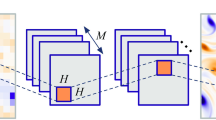Abstract
Detecting the small-scale details of the turbulent/non-turbulent interface (TNTI) is challenging for experimental data due to noise disturbance. To shed new light on this issue, a robust TNTI detection method is proposed in the present paper. This method is based on tracking the Lagrangian trajectories of fluid particles which are bound to fluctuate violently in turbulent regions. The duration of tracking is restricted to avoid the accumulating errors introduced by the entrainment process, the noise and the spanwise velocity. The TNTI is then recognized as the isoline of the velocity fluctuation along trajectories with a threshold identified by the plateau in the curve of TNTI-mean-height against threshold. Comparisons with existing approaches show that the proposed method is able to capture more detailed small-scale structures of the TNTI, while being robust with a noise level of the free stream velocity up to 1.6%. Thus, more detailed geometric and dynamic characteristics of the interface could be explored with experiments.
Graphic abstract









Similar content being viewed by others
References
Borrell G, Jiménez J (2016) Properties of the turbulent/non-turbulent interface in boundary layers. J Fluid Mech 801:554–596
Champagnat F, Plyer A, Le Besnerais G et al (2011) Fast and accurate PIV computation using highly parallel iterative correlation maximization. Exp Fluid 50:1169–1182
Chauhan K, Philip J, De Silva CM et al (2014) The turbulent/non-turbulent interface and entrainment in a boundary layer. J Fluid Mech 742:119–151
da Silva CB, Hunt JC, Eames I, Westerweel J (2014) Interfacial layers between regions of different turbulence intensity. Annu Rev Fluid Mech 46:567–590
Holzner M, Liberzon A, Guala M et al (2006) Generalized detection of a turbulent front generated by an oscillating grid. Exp Fluids 41:711–719
Holzner M, Lüthi B, Tsinober A, Kinzelbach W (2009) Acceleration, pressure and related quantities in the proximity of the turbulent/non-turbulent interface. J Fluid Mech 639:153–165
Holzner M, Lüthi B (2011) Laminar superlayer at the turbulence boundary. Phys Rev Lett 106:134503
Jiménez J, Hoyas S, Simens MP, Mizuno Y (2010) Turbulent boundary layers and channels at moderate Reynolds numbers. J Fluid Mech 657:335–360
Kim K, Baek S-J, Sung HJ (2002) An implicit velocity decoupling procedure for the incompressible Navier-Stokes equations. Int J Numer Method Fluid 38:125–138
Lee J, Sung HJ, Zaki TA (2017) Signature of large-scale motions on turbulent/non-turbulent interface in boundary layers. J Fluid Mech 819:165–187
Li R-Y, Xie C-M, Huang W-X, Xu C-X (2016) An efficient immersed boundary projection method for flow over complex/moving boundaries. Comput Fluid 140:122–135
Long Y, Wang J, Wang J (2020) Vortices evolution in the flow over a sharp leading edge at low Reynolds number. Exp Therm Fluid Sci 112:109987
Lund TS, Wu X, Squires KD (1998) Generation of turbulent inflow data for spatially-developing boundary layer simulations. J Comput Phys 140:233–258
Ma M, Huang W-X, Xu C-X (2019) A dynamic wall model for large eddy simulation of turbulent flow over complex/moving boundaries based on the immersed boundary method. Phys Fluid 31:115101
Mistry D, Philip J, Dawson JR, Marusic I (2016) Entrainment at multi-scales across the turbulent/non-turbulent interface in an axisymmetric jet. J Fluid Mech 802:690–725
Mistry D, Philip J, Dawson JR (2019) Kinematics of local entrainment and detrainment in a turbulent jet. J Fluid Mech 871:896–924
Neamtu-Halic MM, Krug D, Mollicone JP, van Reeuwijk M, Haller G, Holzner M (2020) Connecting the time evolution of the turbulence interface to coherent structures. J Fluid Mech 898:A3
Nolan KP, Zaki TA (2013) Conditional sampling of transitional boundary layers in pressure gradients. J Fluid Mech 728:306–339
Reuther N, Kähler CJ (2018) Evaluation of large-scale turbulent/non-turbulent interface detection methods for wall-bounded flows. Exp Fluid 59:121
Silva TS, Zecchetto M, da Silva CB (2018) The scaling of the turbulent/non-turbulent interface at high Reynolds numbers. J Fluid Mech 843:156–179
Smagorinsky J (1963) General circulation experiments with the primitive equations: I. Basic Exp Mon Weather Rev 91:99–164
Watanabe T, da Silva CB, Sakai Y et al (2016) Lagrangian properties of the entrainment across turbulent/non-turbulent interface layers. Phys Fluid 28:031701
Watanabe T, Zhang X, Nagata K (2018) Turbulent/non-turbulent interfaces detected in DNS of incompressible turbulent boundary layers. Phys Fluid 30:035102
Wolf M, Lüthi B, Holzner M, Krug D, Kinzelbach W, Tsinober A (2012) Investigation on the local entrainment velocity in a turbulent jet. Phy Fluid 24:105110
Wu Z, Lee J, Meneveau C, Zaki T (2019) Application of a self-organizing map to identify the turbulent-boundary-layer interface in a transitional flow. Phys Rev Fluid 4:023902
Xia Q-J, Huang W-X, Xu C-X (2017) Direct numerical simulation of turbulent boundary layer over a compliant wall. J Fluid Struct 71:126–142
Yasuda T, Vassilicos JC (2018) Spatio-temporal intermittency of the turbulent energy cascade. J Fluid Mech 853:235–252
Acknowledgements
We sincerely thank Prof. Wei-Xi Huang, Tsinghua University for generous sharing of the large eddy simulation data. This work is supported by National Natural Science Foundation of China under Grant No. 91852206 and 11721202.
Author information
Authors and Affiliations
Corresponding author
Additional information
Publisher's Note
Springer Nature remains neutral with regard to jurisdictional claims in published maps and institutional affiliations.
Rights and permissions
About this article
Cite this article
Long, Y., Wu, D. & Wang, J. A novel and robust method for the turbulent/non-turbulent interface detection. Exp Fluids 62, 138 (2021). https://doi.org/10.1007/s00348-021-03231-6
Received:
Revised:
Accepted:
Published:
DOI: https://doi.org/10.1007/s00348-021-03231-6




